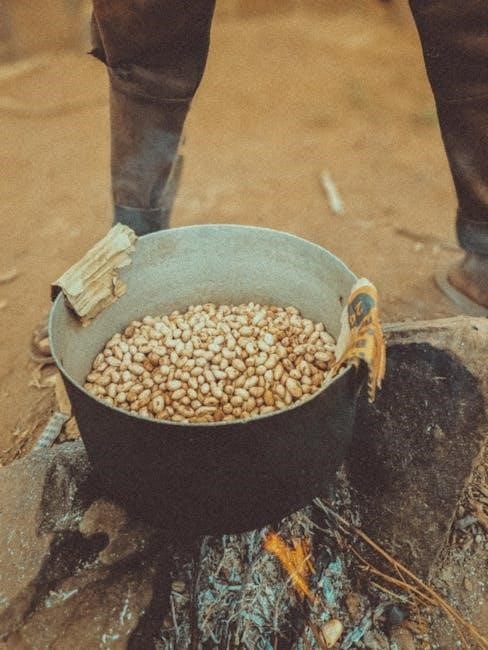Saxon Math 6/5 Teacher Edition PDF: An Overview
The Saxon Math 6/5 Teacher Edition PDF provides comprehensive support for educators․ It complements the student textbook‚ offering detailed lesson plans and answer keys․ This resource aids effective instruction and assessment within the Saxon Math curriculum․
What is Saxon Math 6/5?
Saxon Math 6/5 is a comprehensive mathematics program designed primarily for students in the 5th or 6th grade․ It serves as a bridge between elementary arithmetic and more advanced mathematical concepts․ The curriculum is structured to build upon previously learned material‚ reinforcing skills through consistent review and practice․ Students who have completed Saxon Math 5/4 or an equivalent program are typically prepared to begin Saxon Math 6/5․ The course introduces new concepts incrementally while continually revisiting previously covered topics to ensure retention․ This approach helps students develop a strong foundation in essential mathematical principles‚ preparing them for success in future math courses like Saxon 7/6 and beyond․ Saxon Math 6/5 emphasizes problem-solving skills and real-world applications of mathematical concepts․
Key Features of Saxon Math 6/5
Saxon Math 6/5 is known for its incremental approach‚ spiral review‚ and emphasis on problem-solving․ These features promote mastery and long-term retention of mathematical concepts for students․
Incremental Development Approach
The incremental development approach is a cornerstone of Saxon Math 6/5․ This method introduces new concepts in small‚ manageable increments‚ building upon previously learned material․ Each lesson focuses on a single new concept‚ allowing students to grasp the fundamentals before moving on to more complex topics․ This gradual progression helps prevent overwhelm and promotes a deeper understanding․ Regular practice and review reinforce these concepts‚ ensuring students retain the information․ According to Stephen Hake‚ author of Saxon Math‚ this method is beneficial for solidifying a student’s mathematical foundation․ The incremental approach provides a structured and supportive learning environment‚ fostering confidence and success in mathematics․
Spiral Review System
Saxon Math 6/5 utilizes a spiral review system to reinforce previously learned concepts․ This means that topics are revisited and practiced throughout the course‚ preventing students from forgetting essential skills․ Each daily problem set includes a mix of new material and review problems‚ ensuring continuous exposure to a wide range of mathematical concepts․ This constant review helps solidify understanding and promotes long-term retention․ The spiral approach allows students to build upon their existing knowledge base‚ gradually increasing their proficiency․ Regular exposure to past material also prepares students for cumulative assessments and standardized tests․ This system ensures mastery and a strong mathematical foundation․
Emphasis on Problem Solving
Saxon Math 6/5 places a significant emphasis on problem-solving skills․ The curriculum integrates word problems into daily lessons‚ encouraging students to apply their mathematical knowledge to real-world scenarios․ These problems require critical thinking and analytical skills‚ pushing students beyond rote memorization․ The Teacher Edition provides guidance on how to approach and solve various types of problems‚ offering strategies and techniques for students to master․ By consistently engaging with word problems‚ students develop a deeper understanding of mathematical concepts and their practical applications․ This emphasis equips them with the ability to analyze situations‚ formulate solutions‚ and confidently tackle complex challenges in mathematics and beyond;

Components of the Teacher Edition
The Teacher Edition includes lesson plans‚ answers to student problems‚ and assessments․ These components facilitate effective teaching‚ provide solutions for grading‚ and offer tools for student evaluation․
Lesson Plans and Teaching Strategies
The Saxon Math 6/5 Teacher Edition PDF provides structured lesson plans designed to guide educators through each concept․ These plans often incorporate incremental development‚ introducing new material in manageable steps‚ aligning with Saxon’s pedagogical approach․ Teaching strategies within the Teacher Edition emphasize active learning and problem-solving․ Suggestions for incorporating manipulatives‚ real-world examples‚ and group activities are frequently included․ The lesson plans offer support for differentiating instruction‚ adapting to diverse student needs․ Furthermore‚ they often integrate review activities‚ reinforcing previously learned concepts through the spiral review system․ Detailed explanations and background information are provided to equip teachers with a thorough understanding of the material‚ enabling confident lesson delivery․ The strategies aim to foster a deeper understanding and promote student success․
Answers to Student Edition Problems
A crucial component of the Saxon Math 6/5 Teacher Edition PDF is the inclusion of complete answer keys to all problems in the student textbook․ These answer keys often feature detailed‚ step-by-step solutions‚ allowing teachers to readily understand the problem-solving process․ These detailed solutions are invaluable for grading assignments‚ identifying student errors‚ and providing targeted feedback․ The availability of answer keys streamlines the assessment process‚ saving teachers valuable time․ Furthermore‚ the inclusion of step-by-step solutions allows teachers to model correct problem-solving techniques and provide clear explanations to students․ The answer keys also facilitate self-checking for students‚ empowering them to take ownership of their learning․ The comprehensive nature of the answer keys ensures that teachers have the resources necessary to effectively support student learning and achievement in Saxon Math 6/5․
Tests and Worksheets
The Saxon Math 6/5 Teacher Edition PDF typically includes a collection of tests and worksheets designed to assess student understanding and provide additional practice․ These assessment materials are aligned with the curriculum’s incremental development and spiral review approach․ Tests are provided to evaluate student mastery of concepts covered in each section or unit․ Worksheets offer supplementary exercises to reinforce learning and address specific skill gaps․ The availability of these resources allows teachers to monitor student progress effectively and tailor instruction to meet individual needs․ The worksheets and tests often include a variety of problem types‚ promoting critical thinking and problem-solving skills․ Answer keys are also included for all tests and worksheets‚ facilitating efficient grading and feedback․ By using these components‚ teachers can ensure students are mastering the material․

Availability of PDF Resources
Saxon Math 6/5 Teacher Edition PDFs can be found online‚ though availability varies․ Consider legality when downloading․ These PDFs offer convenient access to teaching materials‚ aiding lesson preparation and instruction․
Where to Find Saxon Math 6/5 Teacher Edition PDFs
Locating Saxon Math 6/5 Teacher Edition PDFs often involves searching online repositories and educational resource websites․ Some sources may offer free downloads‚ while others require a purchase or subscription․ It’s crucial to verify the authenticity and completeness of any downloaded PDF to ensure it matches the official teacher’s edition․
Be cautious of websites offering unauthorized copies‚ as these may infringe on copyright laws․ Check educational forums‚ online groups‚ or libraries for potential leads on legitimate PDF versions․ Reputable online bookstores may also offer digital teacher editions for purchase‚ providing a secure and legal way to access the material․
Legality of Downloading Teacher Editions
Downloading Saxon Math 6/5 Teacher Edition PDFs without proper authorization raises significant legal concerns․ Teacher editions are typically protected by copyright‚ and unauthorized distribution infringes upon the publisher’s rights․ Illegally obtained PDFs may lack essential content or be of poor quality‚ hindering effective teaching․
Purchasing the teacher’s edition or accessing it through authorized online platforms ensures compliance with copyright laws and guarantees access to the complete‚ updated resource․ Educators should prioritize legal avenues to avoid potential legal repercussions and to support the creators and publishers of educational materials․ Respecting copyright fosters a sustainable environment for educational resource development․

Benefits of Using the Teacher Edition
The Saxon Math 6/5 Teacher Edition streamlines lesson preparation and delivery․ It enhances teaching effectiveness with detailed guidance and comprehensive solutions․ This valuable resource supports successful implementation of the curriculum․
Effective Lesson Delivery
The Teacher Edition significantly aids in effective lesson delivery by providing structured lesson plans and teaching strategies․ It offers detailed explanations of concepts‚ ensuring teachers can confidently present the material․ Access to answer keys allows for quick verification of student work‚ facilitating immediate feedback and correction․
The comprehensive nature of the Teacher Edition helps teachers anticipate potential student difficulties and address them proactively․ Moreover‚ it includes supplementary materials like worksheets and tests‚ enhancing the instructional experience․ The organized format ensures lessons are delivered smoothly and efficiently‚ maximizing learning outcomes․ This resource is invaluable for both experienced and new Saxon Math instructors‚ ensuring consistent and high-quality instruction․ By using the Teacher Edition‚ teachers can focus on engaging students and fostering a deeper understanding of mathematical principles․
Assessment and Grading
The Saxon Math 6/5 Teacher Edition PDF streamlines assessment and grading processes․ It contains complete answer keys for all student exercises‚ problem sets‚ and tests‚ enabling efficient evaluation of student performance․ The availability of pre-made tests and worksheets further simplifies the assessment process‚ providing teachers with readily available tools to gauge student understanding․
The Teacher Edition also offers guidance on interpreting assessment results‚ helping teachers identify areas where students may need additional support․ This allows for targeted intervention and personalized instruction․ Furthermore‚ consistent use of the provided assessments ensures a standardized approach to grading‚ promoting fairness and accuracy․ Access to these resources saves valuable time‚ allowing educators to focus more on teaching and less on administrative tasks‚ ultimately enhancing the learning experience for students․

Alternatives to PDF Teacher Editions
Besides PDFs‚ educators can utilize printed teacher editions or explore online Saxon Math resources․ These options provide varied formats for accessing teaching materials and support‚ catering to different preferences․
Printed Teacher Editions
Printed teacher editions offer a tangible alternative to PDFs․ These physical copies provide a comprehensive resource‚ often including lesson plans‚ answer keys‚ and teaching strategies․ They eliminate the need for electronic devices during instruction․ The printed format allows for easy note-taking and highlighting directly within the text․ Some educators prefer the tactile experience and find it easier to navigate a physical book․ Additionally‚ printed editions avoid potential issues with screen fatigue or technological glitches․ They are readily available for purchase‚ offering a reliable and familiar format for implementing the Saxon Math 6/5 curriculum effectively in the classroom or homeschool setting‚ with a comfortable learning experience․
Online Saxon Math Resources
Beyond PDFs and printed editions‚ various online resources support Saxon Math 6/5․ These platforms often feature interactive lessons‚ video tutorials‚ and practice exercises․ Some sites provide assessments and progress tracking tools to monitor student understanding․ Online forums and communities allow teachers and parents to connect‚ share tips‚ and ask questions․ Digital resources can offer engaging and dynamic learning experiences‚ catering to different learning styles․ Interactive elements can help students visualize concepts and reinforce their understanding․ However‚ it’s crucial to evaluate the credibility and alignment of these resources with the official Saxon Math curriculum․ Ensure that online materials supplement‚ rather than replace‚ the core teaching methods․








































